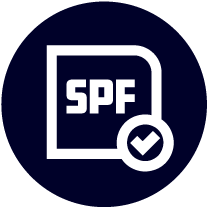Utilisez l’outil de vérification pour valider
vos enregistrements DMARC en quelques secondes
Pour mettre en œuvre le protocole DMARC, vous devez disposer d’un enregistrement valide. Pour effectuer une vérification d’enregistrement DMARC, il vous suffit d’indiquer le nom de domaine de votre entreprise. Le service de vérification de Mimecast recherchera alors votre enregistrement DMARC dans le DNS et renverra un message d’erreur si celui-ci n’est pas disponible ou n’a pas été trouvé.
Si l’enregistrement DMARC de votre domaine est trouvé, la politique sera affichée (voir le glossaire ci-dessous pour la définition des balises trouvées dans les résultats du vérificateur). Les résultats indiquent également s’il y a des problèmes avec votre enregistrement DMARC et si vous utilisez des domaines externes.
Vos résultats
Enregistrement DMARC complet
Declared tags
Defaulted tags
| Tag | Value | Description |
|---|---|---|
| v | Version du protocole DMARC. | |
| p | Appliquez cette politique aux e-mails qui échouent au contrôle DMARC. Cette règle peut être définie sur none, quarantine ou reject. La valeur none est utilisée pour recueillir le rapport DMARC et obtenir un aperçu des flux de courrier électronique actuels et de leur état. | |
| rua | Une liste d’URI pour les FAI à qui envoyer un rapport XML. ATTENTION : il ne s’agit pas d’une liste d’adresses e-mail. DMARC exige une liste d’URI sous la forme mailto:test@exemple.com. | |
| ruf | Une liste d’URI pour les FAI à qui envoyer des rapports d’analyse. ATTENTION : il ne s’agit pas d’une liste d’adresses e-mail. DMARC exige une liste d’URI sous la forme mailto:test@exemple.org. | |
| pct | La balise pourcentage indique aux FAI de n’appliquer la politique DMARC qu’à un pourcentage d’e-mails qui échouent. « pct=50 » indiquera aux récepteurs de n’appliquer la politique p= que 50 % du temps aux e-mails qui échouent à la vérification DMARC. REMARQUE : cela ne fonctionnera pas pour la politique none, mais uniquement pour les politiques quarantine ou reject. | |
| fo | 0 | Options d’analyse forensique. Valeurs autorisées : 0 pour générer des rapports si DKIM et SPF échouent, 1 pour générer des rapports si DKIM ou SPF ne produit pas un résultat DMARC positif, d pour générer un rapport si DKIM a échoué ou s si SPF a échoué. |
| rf | afrf | Le format des rapports forensiques. Il peut s’agir de afrf ou de iodef. |
| adkim | r | Spécifie le mode de correspondance pour les signatures DKIM, qui peut être r (relaxed) ou s (strict). En mode relaxed, les domaines de signature DKIM authentifiés (d=) qui partagent un domaine d’organisation avec un domaine d’origine d’un e-mail passeront le contrôle DMARC. En mode strict, une correspondance exacte est requise. |
| aspf | r | Spécifie le mode de correspondance pour les valeurs SPF, qui peut être r (relaxed) ou s (strict). En mode relaxed, les domaines SPF authentifiés qui partagent un domaine d’organisation avec un domaine d’origine d’un e-mail passeront le contrôle DMARC. En mode strict, une correspondance exacte est requise. |
| sp | p=value | Cette politique doit être appliquée aux e-mails provenant d’un sous-domaine du domaine qui n’ont pas été validés par le contrôle DMARC. En utilisant cette balise, les propriétaires de domaines peuvent publier une politique wildcard pour tous les sous-domaines. |
| ri | 86400 | L’intervalle de reporting pour la fréquence à laquelle vous souhaitez recevoir des rapports XML agrégés. Il s’agit d’une préférence et les FAI peuvent (et vont très probablement) envoyer le rapport à des intervalles différents (généralement, il s’agit d’un rapport quotidien). |
Souhaitez-vous que vos résultats vous soient envoyés par e-mail ?
Félicitations !
Votre formulaire a été envoyé.







